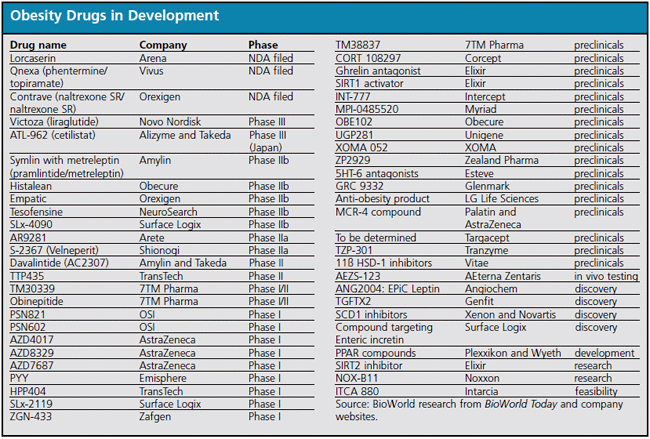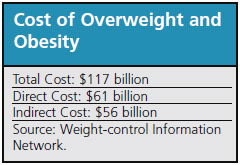Obesity is a worldwide problem most obviously seen in developed countries. The Centers for Disease Control and Prevention estimates that more than a third of Americans - about 72 million people - are obese, and another third are overweight.
If current trends continue, 43 percent of U.S. adults will be obese and obesity spending will quadruple to $344 billion by 2018, according to a study released in late 2009. On the other hand, if obesity rates hold steady, the U.S. would save nearly $200 billion in health care costs - or about $820 per adult.
With the overall U.S. market for weight-loss remedies and diet products sitting at more than $50 billion, the obesity market has been touted as a potential goldmine. In the U.S., drug options for obesity include the generic drug phentermine, F. Hoffmann-La Roche Ltd.'s Xenical (orlistat) and Abbott's Meridia (sibutramine HCl monohydrate capsules C-IV) and nonprescription Alli (low-dose orlistat, GlaxoSmith-Kline plc). But despite these few successes, it's been more of a graveyard, littered with the failures of Pfizer Inc.'s CP-945,598, Merck & Co. Inc.'s taranabant, Sanofi-Aventis Group's Acomplia (rimonabant) and Wyeth's Fen-Phen (dexfenfluramine/phentermine). Even the drugs that have made it to market (and stayed there) have offered modest efficacy, troubling side effects and disappointing sales. Prescription pharmaceutical products account for less than 1 percent of the total obesity market, while surgery is viewed as the most effective option for morbidly obese patients. But that may be about to change.
Globally, the World Health Organization projects that 400 million adults are obese and 1.6 billion are overweight. Those figures are expected to grow to 700 million and 2.3 billion, respectively, by 2015. But most folks don't need statistics to convince them that obesity is a problem; one trip to a local shopping mall, gym, airport or restaurant is usually enough to observe and verify the world's expanding waistline.

Combination Drugs Could Deliver Twice the Efficacy and Billions in Market Potential
Building a better obesity drug is no easy task. Obesity involves a host of genetic, behavioral, emotional and socio-cultural factors. And any successful drug will be taken by millions of patients, resulting in a safety hurdle that will "probably be greater than for any other drug out there," said JPMorgan analyst Cory Kasimov.
But physician consultants that JPMorgan spoke with believe single agents will have "limited benefit because they can only target one pathway effectively, which is likely insufficient to produce long-term, sustained weight loss." The doctors believe that "the combination approach will become standard of care," Kasimov wrote.
As evidence, Kasimov points out that the only prescription drug ever to produce significant weight loss and take the obesity market by storm was, in fact, a combination drug. The infamous Fen-Phen, prior to being recalled for safety issues, demonstrated 15 percent weight loss and generated more than 20 million prescriptions annually.
Today's combination drugs for obesity are built from generics, which Kasimov said allows their safety profiles to be well understood. Two advanced products are Orexigen Therapeutics Inc.'s Contrave and Vivus Inc.'s Qnexa.
For example, Orexigen's Contrave combines long-acting versions of naltrexone, an opioid blocker approved for opioid and alcohol addiction, and bupropion, a dopamine stimulator approved for depression and smoking cessation.
Orexigen's former president and CEO, Gary Tollefson, explained that the two drugs affect the reward pathways associated with food addictions, both on the involuntary level that regulates hunger and energy burn, and on the voluntary level that causes excessive eating. Additionally, bupropion enhances weight loss by increasing energy burn, a normally short-lived benefit that naltrexone helps to extend. And bupropion has anti-depressive effects, addressing a frequent co-morbidity of obesity.
Even more dramatic weight loss may come from Orexigen's second product candidate, Empatic, a combination of long-acting bupropion and long-acting zonisamide, a seizure drug believed to modulate sodium channels and enhance dopamine and serotonin activity. The zonisamide inhibits neurons that contribute to the weight loss plateau by promoting energy storage and hunger when weight starts to drop off. This ability to prevent weight gain synergizes with bupropion's ability to promote weight loss. Pooled trial data show Empatic offers average weight loss of 7.5 percent after 24 weeks, which increased to 14 percent after a year according to Phase IIb.
Vivus's Qnexa also seeks to create a synergistic effect by combining the generic diet drug phentermine with topiramate, a drug approved for epilepsy and for migraine prevention.
Separately, phentermine and topiramate have only mild weight loss effects, but together they produce "true synergy" due to the fact that they target different areas in the brain, said Vivus Director of Clinical Development Barbara Troupin. She added that the two drugs also mitigate each other's side effects, since topiramate tends to dull the senses while phentermine stimulates them. Qnexa also uses low doses of both drugs to decrease the incidence of side effects.
So far, the synergy appears to be working. In a Phase II trial, Qnexa produced average placebo-adjusted weight loss of 8.6 percent in 24 weeks, with a drop-out rate of just 8 percent. JPMorgan's physician consultants said they believe the product "may potentially have a best-in-class clinical profile." But analysts have expressed concern about the fact that the Phase II trial was conducted at a single trial site.
In the end, Kasimov predicted that the risk associated with the drugs will come from regulatory and commercial issues. That's where the expertise of a big pharma partner will come in handy, he said, adding that it's "a question of when, not if" the obesity drugs will eventually be partnered. Once they are, he expects all three to find a place in the obesity market, which he said has "room for multiple players." Kasimov projected that as these and other new products gain approval, the market for prescription obesity drugs will grow from $200 million in 2007 to $1.5 billion in 2012 and more than $4.6 billion in 2017.



